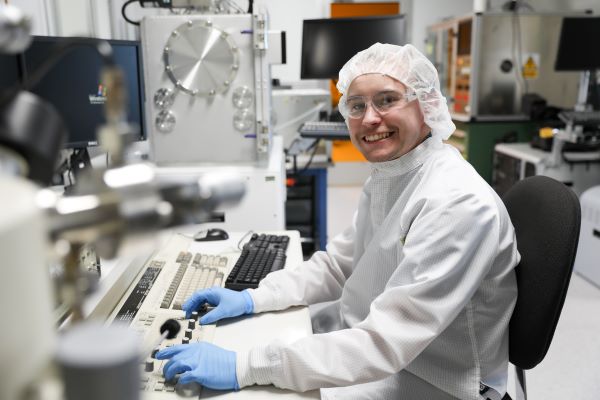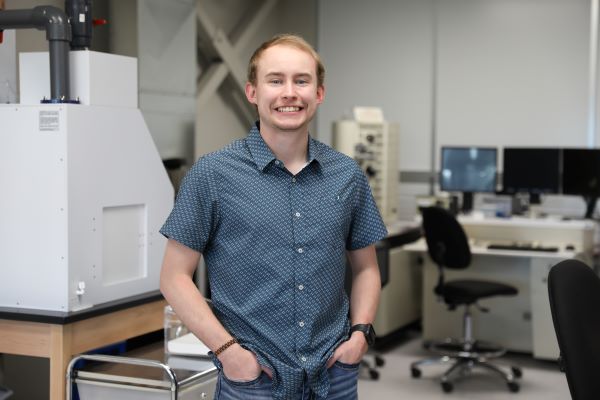Montana Tech mechanical engineering student lands fellowship at Brookhaven National Laboratory

Jakob Nielsen, a third-year mechanical engineering student at Montana Technological University, will join 24 top students from around the United States at Nuclear Chemistry Summer School (NCSS) at the Brookhaven National Laboratory this summer. The journey to the East Coast Department of Energy facility that has produced seven Nobel-Prize winning discoveries is one of determination and commitment to science that ignited six years ago during his sophomore year at Butte High.

“I was bored during the pandemic,” Nielsen said. “I played all sports in high school that I could do. I got my physical stimulation that way, but I really wanted to improve my academics, so I reached out to the Montana Tech Nanotechnology Laboratory, and they said that they were pretty open to having new people in there.”
The Montana Tech Nanotechnology Laboratory (MTNL) is home to a clean room with a powerful scanning electron microscope and a transmission electron microscope and other specialty equipment valued at over $1 million. The lab was not able to accommodate Nielsen’s request during the pandemic, but in his junior year of high school Dr. Jack Skinner, interim dean of the Lance College of Mines and Engineering, gave Nielsen the opportunity to come to campus and assist in research.
As Dr. Skinner paraphrased from Jakob’s recommendation letter for the NCSS, “His creative, enthusiastic, and knowledgeable approach to research is uncommon and greatly needed within the scientific community. Along with being highly talented technically and exceptionally motivated, Jakob truly excels at his interpersonal skills, always exhibiting a positive attitude and lending a helping hand to those around him. I am proud to call him a member of my research group and the Lance College of Mines and Engineering. He is on a remarkable trajectory as he finishes his undergraduate education and prepares for a Ph.D. education to continue to help improve the human condition.”
“I was the 10th person in the clean room, ever,” Nielsen said.
Teenaged Nielsen was not intimidated at all when he started working with researchers without any experience. He jumped right in and never looked back. Nielsen was assigned to work under Ph.D. Materials Science student Harold Pearson-Nadal two or three times a week after school.
“From there it just of took off,” Nielsen said. “It really helped me grow academically, grow as a researcher. Everyone in the lab was super helpful.”
Tissues for laboratory testing are traditionally grown one-cell thick on the bottom of a flask. In removing cells from a flask, they are treated to separate the individual cells, thereby breaking apart the tissue. In this work, fibrous scaffolds fabricated by a process called electrospinning provided a three-dimensional framework for tissues to grow more similarly to how they do in humans. In this form, three dimensional tissues can be grown in the lab and moved without breaking apart the cells. Along with Pearson-Nadal, Nielsen built a physiological flow cell that exposes those 3D tissues to physiological pressures and flows that better mimic human cardiac activity including pulses that mimic a heartbeat. The model will be used to enable prediction of tissue damage under stress “I really enjoyed that project,” Nielsen said.
By the time Nielsen enrolled as a first-year student at Montana Tech, after turning down offers from Montana State University and Rensselaer Polytechnic Institute, he was on the lab’s payroll, poised to leverage his existing familiarity with its advanced equipment from day one.
“Having the opportunity to do hands-on research right away as a freshman was important and being paid was another good bonus,” Nielsen said. “I also already knew everyone. Those things are definitely part of what drove me choose to Montana Tech.”
The Montana Tech Nanotechnology Laboratory is a versatile space. So, in addition to working on bioengineering projects with Harold, Nielsen was able to work on a project involving critical mineral recovery. Rare earth elements are critical to most modern electronics. However, they are remarkably similar, often found in the same mineral deposits and incredibly difficult to separate. The DEVCOM Army Research Lab has funded multiple projects at Montana Tech over the past few years to develop ways to recover these minerals, including one project that Nielsen was able to participate in.
The Montana Tech Nanotechnology Laboratory invented a patented nanoparticle that enables rare earth element recovery and separation. Another exciting aspect of the particle, is that it is highly biocompatible. Nanomaterials can easily be lost to the environment, and it was important to MTNL to develop a particle that, if lost, wouldn’t negatively impact the environment. In Jakob’s work, he collected 330 samples to determine the adsorption capabilities of the nanoparticle on a broad range of rare earth elements, including heavy and light types that are notoriously hard to separate. In addition to finding that the nanoparticle adsorbed 100 % of all rare earth elements examined after just three hours, the data also shows a high proficiency of lanthanum separation after just 60 min. In future work, the nanoparticle will be used to remove or collect lanthanum from complex rare earth element solutions. In addition to majoring in mechanical engineering, Nielsen is also working toward a minor in chemistry, which dovetails nicely with his fellowship at Nuclear Chemistry Summer School at the Brookhaven National Laboratory. According to the school’s website, during the six-week program, Nielsen will have the opportunity to visit nuclear-related and radiochemistry facilities, attend a guest lecture series, and interact with leaders of nuclear science in academics, medicine, industry, government, and the (nuclear) Navy. He’ll receive $4,000 and will earn six college credits from Stony Brook University.
Nielsen is excited for the opportunity, and is already brainstorming his next steps after he completes his senior year. He plans to apply to prestigious graduate schools in another field he wants to explore – physics. If that doesn’t work out Nielsen says he’ll probably pursue biomedical engineering.
He has advice for students considering a future in STEM.
“Be open to opportunities,” Nielsen said. “Don't be afraid to reach out to people, especially at Montana Tech. I reached out to the head of the Mechanical Engineering Department as a sophomore in high school and he emailed me back and that's how I got kicked off with everything. Don’t be afraid to just talk to people if you're motivated and want to get into doing some cool stuff.”